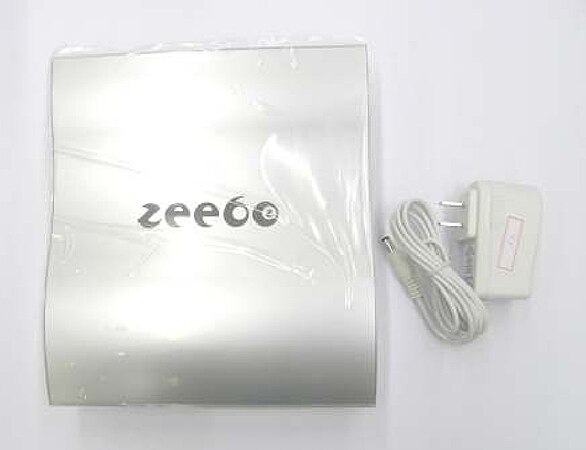History of video games/Platforms/Zeebo
-
A Zeebo console.
History
editDevelopment
editZeebo was developed by the company TecToy,[1] a company which had been involved in distributing the Sega Genesis in Brazil.
Prototypes consisted of a mobile phone motherboard with some extra support hardware.[2]
Launch
editZeebo was set to be launched in Brazil in 2009, with the console costing $249 USD with four included games and a free game download, and games costing at most $15 USD.[3] By September 2009 the Zeebo was available only in Rio De Janeiro, and cost 499 BRL, though it saw a price drop to BRL 399 that month.[4] Later in 2009 Zeebo was released in Mexico.[5]
Discontinuation
editZeebo was discontinued in 2011.[6]
Technology
editThe Zeebo uses a Qualcomm chipset[7] with a 32 bit CPU based on the ARM11 architecture clocked at 528MHz.[8]
The Zeebo is also equipped with a QDSP-5 and a Adreno 130 GPU capable of rendering 4 million triangles a second.[8]
The Zeebo has 160 megabytes of RAM, and 128 megabytes of VRAM.[8]
The Zeebo runs BREW software (Binary Runtime Environment for Wireless) and can be connected to the internet over a 3G wireless connection.[3][9] The Zeebo became one of the earliest home game consoles to feature a wireless mobile internet connection as a standard feature.
User avatars called Zeeboids could be created, similar to Mii avatars on the Wii.[9]
Notable games
editThe Zeeboo had a library of 55 games, none of which could be obtained after official servers shut down in September 30th, 2011.[9] As a result it is possible that some Zeebo titles are lost media.
The Zeebo had ports of Resident Evil 4, FIFA, and Tekken titles.[10][5]
2009
editZeebo Extreme
editRead more about Zeebo Extreme on Wikipedia.
2010
editUn Juego de Huevos
editZeebo exclusive title.
Read more about Un Juego de Huevos on Wikipedia.
External Resources
edit- Video Game Kraken Zeebo page.
- Video Game Console Library - Zeebo page.
References
edit- ↑ "Tectoy's Zeebo gaming console to run on 3G network in Brazil" (in en). Engadget. https://www.engadget.com/2008-11-12-tectoys-zeebo-gaming-console-to-run-on-3g-network-in-brazil.html. Retrieved 25 October 2020.
- ↑ Jordan, Jon. "Why the G1 Google phone might end up the most popular game console ever" (in en). www.pocketgamer.com. https://www.pocketgamer.com/features/why-the-g1-google-phone-might-end-up-the-most-popular-game-console-ever/.
- ↑ a b Reisinger, Don. "The Zeebo game console: Why it matters". CNET. Retrieved 25 October 2020.
- ↑ Remo, Chris. "Zeebo Console Reduces Price, Expands Game Selection" (in en). www.gamasutra.com. https://www.gamasutra.com/view/news/25440/Zeebo_Console_Reduces_Price_Expands_Game_Selection.php. Retrieved 25 October 2020.
- ↑ a b Orland, Kyle. "Zeebo Raises $17M For Internationally-Focused Game Console" (in en). www.gamasutra.com. https://www.gamasutra.com/view/news/126792/Zeebo_Raises_17M_For_InternationallyFocused_Game_Console.php. Retrieved 25 October 2020.
- ↑ July 2013, Jeff Dunn 15. "Chasing Phantoms - The history of failed consoles" (in en). gamesradar. https://www.gamesradar.com/chasing-phantoms-history-failed-consoles/6/. Retrieved 25 October 2020.
- ↑ "Qualcomm MSM chipset Game Console by Zeebo Inc. Launches". ForbesOnTech. Retrieved 28 October 2020.
- ↑ a b c "Home Page". Video Game Console Library. Retrieved 28 October 2020.
- ↑ a b c "Brazil Of Games: The World's First Digital Only Console, And Why It Failed" (in english). Destructoid. https://www.destructoid.com/--547728.phtml#post. Retrieved 25 October 2020.
- ↑ Sheffield, Brandon. "Mike Yuen on Zeebo's Launch, Potential for Indies" (in en). www.gamasutra.com. https://www.gamasutra.com/view/news/27305/Mike_Yuen_on_Zeebos_Launch_Potential_for_Indies.php. Retrieved 25 October 2020.
